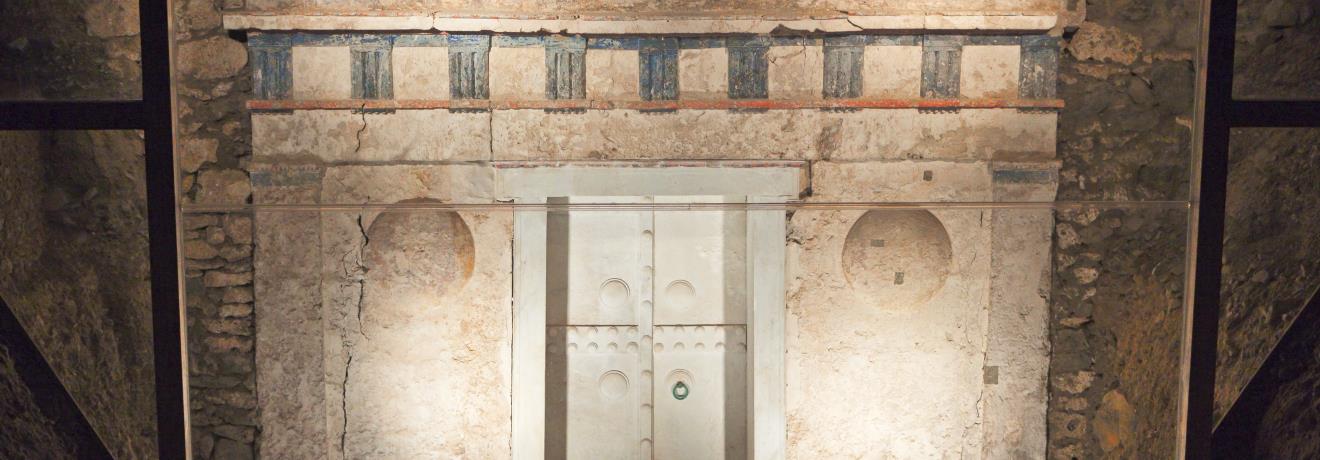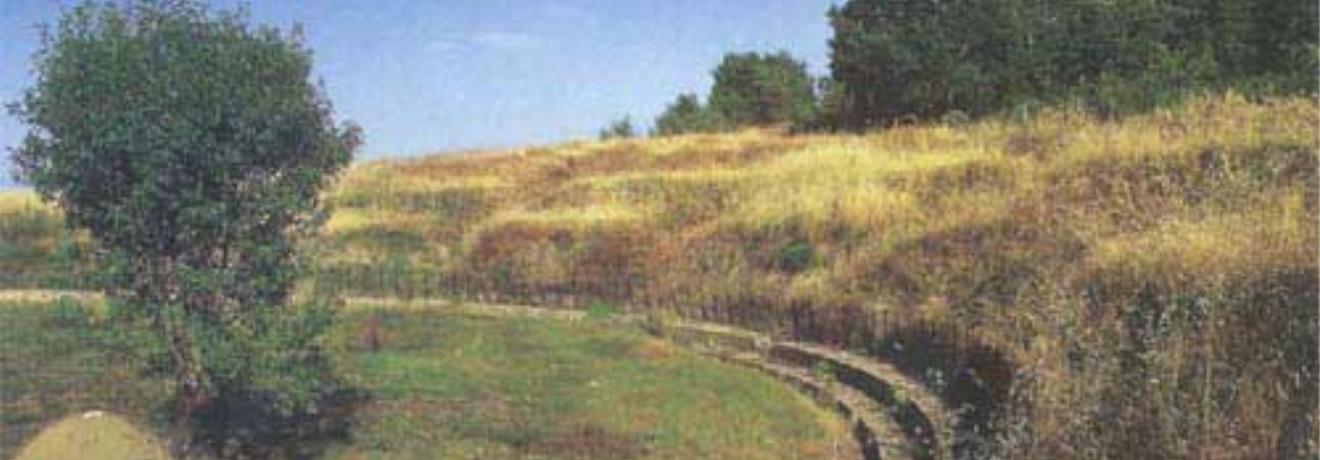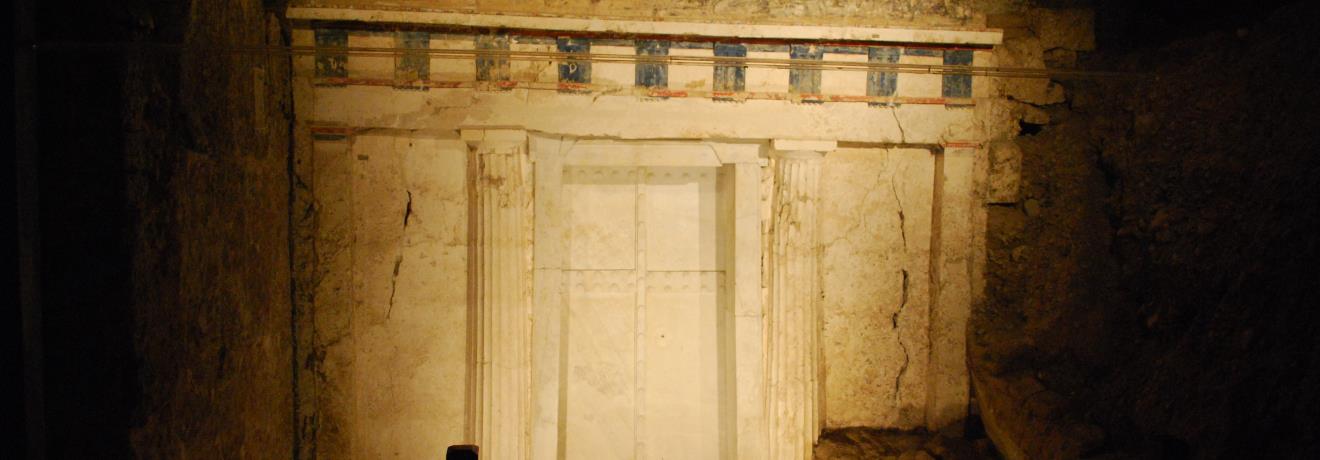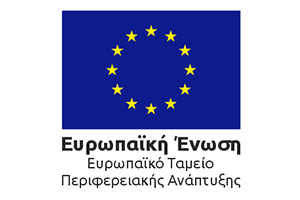The ancient city that lies on the
northern slopes of the Pierian mountains
is securely identified as Aigai, the capital of the kingdom of Lower Macedonia. According to the archaeological evidence, the first settlement on the site dates back to the Early Bronze Age in the 3rd millenium BC and is expanded and densely populated during the Early Iron Age (11th-8th centuries BC). In the following centuries, namely during the Archaic and Classical periods (7th - 5th centuries BC), here is developed a prosperous city, which became the most important urban centre of the area and the capital of the Macedonian kingdom until the end of the 5th century BC, when the seat of the Macedonian kings is transferred to
Pella.
Still Aigai remains the historic, respectable centre of the kingdom, where the kings are buried in the royal necropolis, the traditional cult is practised in the sanctuaries and the official and ritual ceremonies take place.
The first excavations on the site were carried out in the mid-19th century by the French archaeologist L. Heuzey, bringing to light the first Macedonian tomb near the contemporary village of Palatitsia. In 1938 the Archaeological Department of the University of Thessaloniki, under the direction of the Prof. Konstantinos Romaios, initiated the long series of systematic excavations in the area, which, beyond a short break during World War II, continue without interruption to date. In 1976 Prof. Manolis Andronikos revealed the royal tombs of the Great Mound (Toumba) and one year later came to light the tomb of king Philip II (359-336 BC). The excavation of the palace and the theatre followed, while in the last decade the research, conducted by the University of Thessaloniki and the local Archaeological Service, has focused on the excavation of the civic quarters of the ancient city and its extensive cemeteries.
From the onset of the excavations the protection of the priceless but also sensitive finds
(
gold-and-ivory
and
metal objects,
wall paintings)
was an imperative necessity. A laboratory was organised on site for the conservation and restoration of the findings. In 1993 was completed the
subterranean structure that protects the tombs by retaining the stability of the temperature and humidity, which is necessary for the preservation of the wall paintings. Seen from outside, this building resembles an
earthen tumulus.
In the same space are displayed the movable finds, thus the building is simultaneously a
museum
on site sheltering both the monuments and their artefacts within their original context.
Among the most important monuments of the site are:
The royal tombs of the Great Mound (Toumba)
This group includes the renowned tombs of members of the royal Macedonian dynasty:
- The
tomb of Philip II, a monumental tomb of the Macedonian type, with
two chambers and a temple-like facade which combines elements of both the Doric and Ionic order. A typical feature of the latter, the Ionic frieze of the tomb, is decorated with a wall painting that depicts a scene of royal hunting, a rare example of the ancient Greek painting. Among the
central figures is recognized that of Alexander the Great. As this grave remained intact from destructions and plundering, it yielded a wealth of
artifacts, among them the two
gold larnakes,
which contained the bones of the king and its wife.
- The
tomb of Persephone.
This is one of the largest cist graves found so far in Greece. It dates to 350 BC and it probably belonged to Nikesipolis, king Philip's wife and Thessaloniki's mother. The tomb was conventionally named after the theme of its
wall painting,
which depicts the abduction of Persephone by Plouto. The murals of the tombs of Philip and of Persephone comprise the most important specimens of ancient Greek wall painting preserved today. Unfortunately the tomb was looted probably during the invasion of the Gauls, who plundered the royal necropolis of Aigai in the 3rd century BC.
- The
"tomb of the Prince" (tomb of Alexander IV) was built near that of Philip, about 30 years later. It contained the
bones of a young adolescent, maybe the son of Alexander the Great and Roxane, Alexander IV, who was murdered along with his mother by Kassandros, usurper of the throne after the death of Alexander the Great.
- The
tomb of the free-standing columns is the third tomb of the Macedonian type in the Great Tumulus. It dates to the 3rd century BC and probably belonged to Antigonos Gonatas. The monument was heavily damaged due to repeated plundering of its building material and deprived from its most probably wealthy artefacts. The monument had an impressive entrance with four Doric columns, which are partly preserved today.
The cemetery of the tumuli.
This is the imposing necropolis of the Iron Age (11th-8th centuries BC), which includes more than 300 small earthen tumuli, constructed over clusters of burials which contained rich offerings.
The Palace and the Theatre
These two important monuments consist part of a wider building complex of the ancient city that dates to the late 4th century BC. Built on a high, prominent location, the
palace overhung the ancient city.
The
two-storeyed building comprised luxurius halls which were clustered around a central peristyle courtyard and a shrine dedicated to Herakles Patroos. Indicative of the rich decoration is the fine mosaic floor which was preserved in one of the palace rooms. The palace of Aigai is the only example preserved today of an ancient Greek palace dated as early as in the Late Classical period, being a forerunner of its Hellenistic successors.
The theatre was constructed very close to the palace, on a downhill slope. A distinctive architectural feature is the very large orchestra with a diameter of 28 m, while the cavea exploited the natural inclination of the slope, having only one series of stone seats. It was in this theatre that the king Philip II was assassinated in the summer of 336 BC and Alexander the Great was proclaimed king.
The City and its sanctuaries
The ancient city was fortified with a massive wall, which formed a circular enclosure around the city. The architectural remains - public buildings, private houses, workshops - uncovered so far provide a rough picture of the urban planning and the development of the city, a picture that the ongoing excavations keep filling in.
The public nucleus of the city, the agora, was located at a lower level beneath the palace and the theatre. The most important feature for the identification of this part of the
city with the agora, was the
sanctuary of Eukleia, the deity of glory and good repute, whose sanctuaries were erected in the heart of the ancient Greek cities, namely in the agora. In the case of the sanctuary of Aigai, the excavation revealed the foundations of two temples, a peristyle building and a series of offerings, including two bases of votive statues dedicated by the queen Eurydice, grandmother of Alexander the Great. The majority of the architectural remains are dated to the period of reign of Philip II (359-336 BC) and Alexander (336-323).
Of major importance is also the
sanctuary of the Mother of the Gods (Metroon), the panhellenic deity Rhea, which already in the 6th century BC was associated with the Asian goddess Cybele. The sanctuary of Aigai consists of a complex of cult and auxiliary structures, which were erected over the ruins of an earlier sanctuary and date to the beginning of the 3rd century BC. The Hellenistic sanctuary was destroyed in 150 BC.
In 167 BC the Macedonian kingdom submitted to the Romans and, as it was the case with the rest of Greece, became a province of the Roman Empire. The Roman era is for Aigai a period of gradual decline and shrinkage until the mid-1st century AD, when the city is finally abandoned by its inhabitants.





